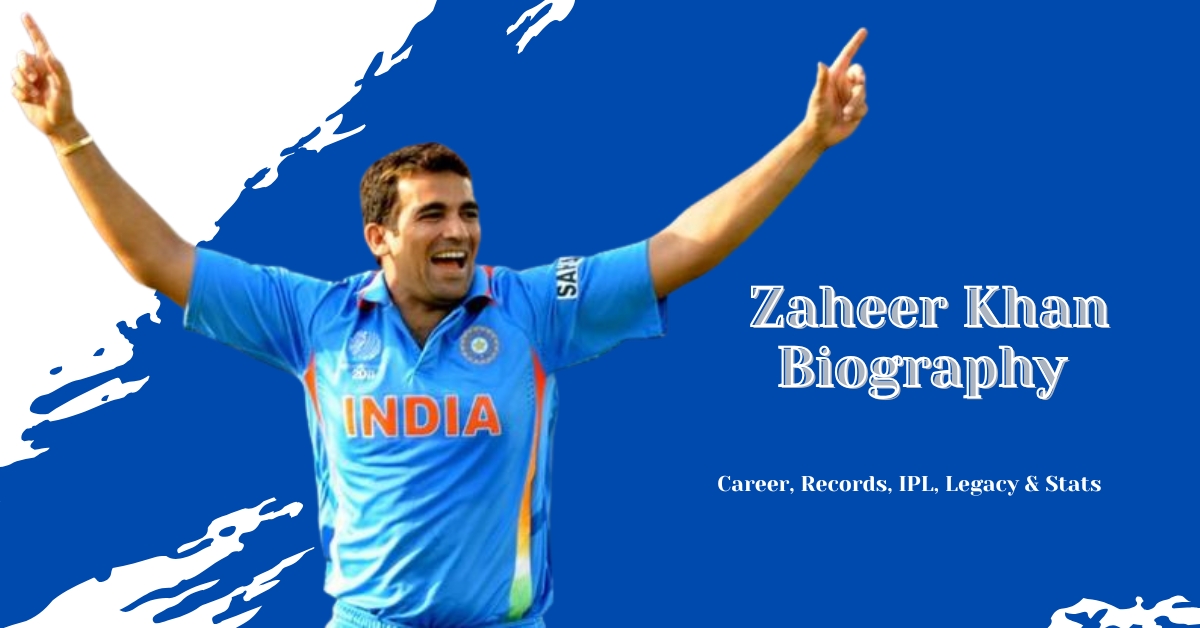Zaheer Khan is one of India’s most successful fast bowlers and a key figure in the country’s cricketing history. Born on October 8, 1978, Zaheer played a pivotal role in transforming India’s pace attack into a world-class unit. A left-arm fast bowler known for his ability to swing the ball both ways, especially reverse swing with the old ball, Zaheer was instrumental in India’s victories across formats during the 2000s and early 2010s. He was a consistent performer in both Test and One Day International (ODI) cricket, especially renowned for his heroics during the 2011 Cricket World Cup, where he was the joint highest wicket-taker. Over a career spanning 14 years, Zaheer Khan claimed more than 600 international wickets and left a lasting legacy on Indian pace bowling.
Early Life and Background
Zaheer Khan was born in Shrirampur, a small town in Maharashtra, India, into a middle-class Muslim family. His father, Bakhtiyar Khan, was a photographer, while his mother was a schoolteacher. From an early age, Zaheer showed immense interest in sports, particularly cricket. He attended New Marathi Primary School and later K.J. Somaiya Secondary School in Mumbai, where his teachers noted his discipline and strong work ethic.
Recognizing his potential, Zaheer moved to Mumbai in his late teens to pursue cricket more seriously. He joined the National Cricket Club and soon caught the eye of the coaches at the MRF Pace Foundation in Chennai, an academy dedicated to grooming fast bowling talent under the guidance of legendary Australian bowler Dennis Lillee. The training and mentorship he received at the MRF Pace Foundation laid a strong foundation for his future career.
Domestic Cricket Career
Zaheer began his first-class cricket career with Baroda in the 1999–2000 domestic season. His performances in the Ranji Trophy were impressive from the start. In his debut season, he helped Baroda win the Ranji Trophy, taking 8 wickets in the final against Railways. His pace, ability to extract movement, and composure under pressure made him one of the most promising bowlers in the domestic circuit.
In 2006, Zaheer briefly played for Worcestershire in English County cricket, where he refined his swing bowling skills under different conditions. He also represented Mumbai in the later stages of his domestic career. His time in domestic cricket proved crucial in building the consistency and stamina needed for the international stage.
International Debut and Rise (2000–2003)
Zaheer Khan made his ODI debut for India against Kenya in the ICC KnockOut Trophy in Nairobi in October 2000. He announced his arrival with a fine spell and a memorable yorker that dismissed Steve Waugh in the semi-final against Australia. His Test debut came shortly after, against Bangladesh in Dhaka in November 2000.
During the 2003 ICC Cricket World Cup in South Africa, Zaheer formed a potent pace trio with Ashish Nehra and Javagal Srinath. Despite a shaky start, he picked up 18 wickets in the tournament, playing a key role in India’s journey to the final. Though India lost to Australia in the final, Zaheer’s performance throughout the tournament was widely praised.
Injury Struggles and Comebacks (2004–2006)
Zaheer’s career between 2004 and 2006 was marred by injuries, particularly hamstring and back issues. His form dipped, and he struggled to maintain a consistent place in the Indian side. These years tested his resilience as he worked on fitness and adjusted his bowling action.
A turning point came during his stint with Worcestershire in 2006, where he took 78 wickets in the English county season. This phase not only restored his confidence but also added new dimensions to his bowling—especially control and swing with the old ball. His performance in England earned him a recall to the Indian side and marked the beginning of his second innings in international cricket.
Peak Years (2007–2011)
Zaheer Khan’s return to the Indian team in 2007 saw him mature into a leader of the pace attack. He played a critical role in India’s overseas victories, including the Test series in England in 2007 where he picked up 18 wickets and was named Player of the Series.
His performances in South Africa and Sri Lanka further solidified his status. He was India’s go-to bowler in crunch situations, known for breaking partnerships and using the reverse swing effectively. In ODIs, his accuracy in the death overs became a valuable asset.
In the 2011 ICC Cricket World Cup, Zaheer was India’s highest wicket-taker with 21 wickets. He bowled brilliantly throughout the tournament, particularly in the final against Sri Lanka, where he delivered three maiden overs at the start. His consistent performance was instrumental in India’s historic World Cup win after 28 years.
Later Years and Retirement (2012–2015)
After the 2011 World Cup, Zaheer’s form and fitness began to decline. Age and recurring injuries started limiting his effectiveness and availability. He continued to play sporadically for India but wasn’t able to recapture his previous form.
His last Test appearance came in February 2014 against New Zealand. In October 2015, Zaheer officially announced his retirement from international and first-class cricket, ending a remarkable career that spanned over a decade and a half.
Indian Premier League (IPL) Career
Zaheer Khan was an integral part of the Indian Premier League (IPL) from its inception. He played for several franchises including Royal Challengers Bangalore (RCB), Mumbai Indians (MI), and Delhi Daredevils (now Delhi Capitals).
With RCB, he played from 2008 to 2010, then moved to MI for a few seasons. In the later stages of his IPL career, he captained Delhi Daredevils and mentored a young bowling unit. His presence and guidance were crucial in shaping emerging fast bowlers. Even in his mid-thirties, Zaheer remained a key performer in the IPL.
Bowling Style and Skills
Zaheer Khan’s bowling was a combination of pace, swing, and intelligent variations. He started his career as a fast, attacking bowler and gradually evolved into a smart, tactical leader of the pace attack. One of his biggest strengths was reverse swing, particularly with the old ball.
He could bowl sharp inswingers and deceptive outswingers with the same action, making it difficult for batsmen to pick. His use of the knuckleball in ODIs also earned him many wickets. He was known for targeting the stumps and inducing mistakes under pressure.
Zaheer’s control and planning were often compared with the best in the world. He is widely regarded as one of India’s greatest left-arm pacers alongside legends like Kapil Dev and Javagal Srinath.
Records and Achievements
- Tests: 92 matches, 311 wickets, average 32.94, best bowling 7/87
- ODIs: 200 matches, 282 wickets, average 29.43, best 5/42
- T20Is: 17 matches, 17 wickets, average 26.35
Major Achievements:
- Leading wicket-taker for India in 2011 World Cup (21 wickets)
- Member of 2011 World Cup-winning team
- Padma Shri award in 2020
- Arjuna Award in 2011
- First Indian pacer to take 10 wickets in a Test match in Bangladesh
Personal Life
Zaheer Khan married Bollywood actress Sagarika Ghatge in 2017. The couple’s wedding was a blend of traditional and contemporary style, widely covered by Indian media. They have often spoken about supporting each other’s careers.
Off the field, Zaheer has been involved in various business ventures including his fitness chain “ProSport Fitness” and the “Zaheer Khan Foundation,” which works for underprivileged children. He is known for his humble demeanor and articulate communication.
Post-Retirement Career
After retirement, Zaheer took on the role of cricket analyst and commentator, providing insights during international matches and in IPL broadcasts.
He was also appointed Director of Cricket Operations for Mumbai Indians, where he played a pivotal role in mentoring young bowlers like Jasprit Bumrah and Rahul Chahar. His contributions behind the scenes have continued to influence Indian cricket.
Legacy and Influence
Zaheer Khan is widely credited with inspiring a generation of Indian fast bowlers. Before his rise, India was traditionally known for spin bowling. He brought variety, aggression, and strategic planning to the pace department.
Many current Indian pacers, including Mohammed Shami, Umesh Yadav, and Jasprit Bumrah, have spoken about Zaheer’s role in shaping their careers. He remains an example of how intelligence, adaptability, and discipline can overcome injuries and challenges.
Popular Media and Recognition
Zaheer has appeared in various interviews, documentaries, and cricket shows. He is often invited as a guest speaker on cricket panels and leadership forums. His story has been featured in several cricket anthologies and video series.
He enjoys a strong fan base for his calm personality and deep understanding of the game. His cultural impact extends beyond cricket into Indian popular culture.
Full Career Stats Tables
Test Career
| Matches | Wickets | Bowling Avg | Best Innings | 5-Wicket Hauls | 10-Wicket Matches |
|---|---|---|---|---|---|
| 92 | 311 | 32.94 | 7/87 | 11 | 1 |
ODI Career
| Matches | Wickets | Bowling Avg | Economy | Best Figures |
| 200 | 282 | 29.43 | 4.93 | 5/42 |
T20I Career
| Matches | Wickets | Bowling Avg | Best Figures |
| 17 | 17 | 26.35 | 4/19 |
IPL Career
| Team | Seasons | Matches | Wickets | Best Figures |
| RCB | 2008–2010 | 23 | 22 | 4/17 |
| Mumbai Indians | 2011–2013 | 30 | 29 | 3/21 |
| Delhi Daredevils | 2015–2017 | 23 | 20 | 3/20 |
Quotes and Tributes
“Zaheer bhai was our leader in the bowling group. He taught us how to bowl with patience and think like a batsman.” — Jasprit Bumrah
“If Zaheer Khan had played in Australia or England, he would be considered among the greatest of all time.” — Michael Holding
“The way he planned dismissals and guided the bowling unit during the 2011 World Cup was phenomenal.” — MS Dhoni
Zaheer Khan himself once said, “Injuries taught me patience, and cricket taught me how to think. I may not have been the fastest, but I tried to be the smartest.”
Zaheer Khan’s journey from a small town in Maharashtra to becoming the spearhead of India’s pace attack is a story of perseverance, skill, and relentless spirit.




